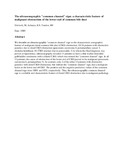The ultrasonographic "common channel" sign: a characteristic feature of malignant obstruction of the lower end of common bile duct

View/
Date
1989Author
Dwivedi, M
Acharya, KS
Tandon, BN
Type
ArticleLanguage
enMetadata
Show full item recordAbstract
We describe an ultrasonographic "common channel" sign as the characteristic sonographic feature of malignant distal common bile duct (CBD) obstruction. Of 24 patients with obstructive jaundice due to distal CBD obstruction (pancreatic carcinoma 8, periampullary cancer 5, choledocholethiasis 10, CBD stricture due to pancreatitis 1) in whom the final diagnosis was proven at laparotomy, ultrasonography revealed 11 patients to have a thin-walled distended gallbladder continuous with a dilated CBD, which was termed the "common channel" sign. In all 11 patients, the cause of obstruction of the lower end of CBD proved to be malignant (pancreatic carcinoma 6, periampullary 5). In contrast, only 2 of the other 13 patients with obstructive jaundice with distal CBD obstruction, but without the "common channel" sign, had a malignant lesion at the lower end of CBD. The positive and the negative predictive values of the common channel sign were 100% and 85%, respectively. Thus, the ultrasonographic common channel sign is a reliable and characteristic feature of distal CBD obstruction due to malignant pathology.
Citation
KIRTDA, DRACHARYAS. 1989. Dwivedi M, Acharya SK, Tandon BN.The ultrasonographic "common channel" sign: a characteristic feature of malignant obstruction of the lower end of common bile duct.J Clin Gastroenterol. 1989 Apr;11(2):233-5.Publisher
Department of Medicine, College of Health Sciences, University of Nairobi
Collections
- Faculty of Health Sciences (FHS) [10378]
